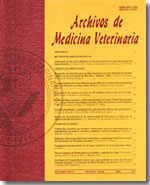Salmo salar: ultrastructural morphology of chorion, from normal and with hatching problems ova
Main Article Content
Abstract
Either eyed alevins unable to digest the chorion or those digesting it partially, are both suffering the “hard chorion” phenomenon; in both cases alevins can not survive producing high mortality rates. During recent years, the salmon farming industry in Southern Chile has been facing massive mortality events caused by “hard chorion”. Since “hard chorion” is a recently observed phenomenon there are no literature reporting its origin. The aim of this study was to find differences in the ultrastructure of chorion fibers from Salmo salar ova at different stages of development by using Scanning Electron Microscopy and image analysis technique. Early results here reported indicated no differences in thickness of chorion fibers for Salmo salar ova at different stages of development, however differences in spatial arrangement of fibers forming the inner layer of chorion seem to explain the “hard chorion” occurrence. No pores were observed in the inner layer of chorion of ova exhibiting “hard chorion” as opposed to normally developed ova which have pores and allow hatching of alevins. Since choriogenin is a protein formed by a number of sub-units, it is possible that failure in synthesis of one of these sub-units might be responsable for an anomalous arrangement of fibers of chorion causing the “hard chorion” phenomenon.

